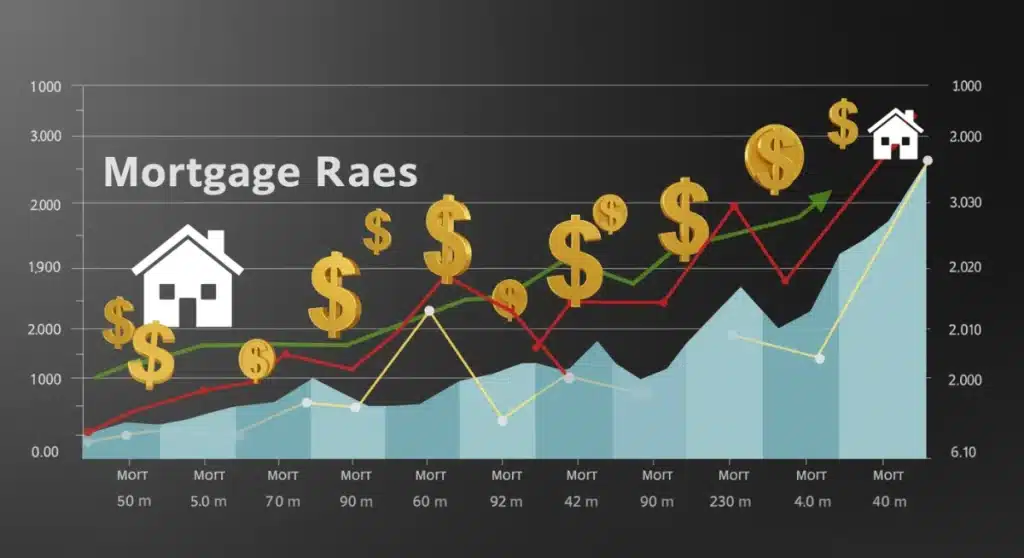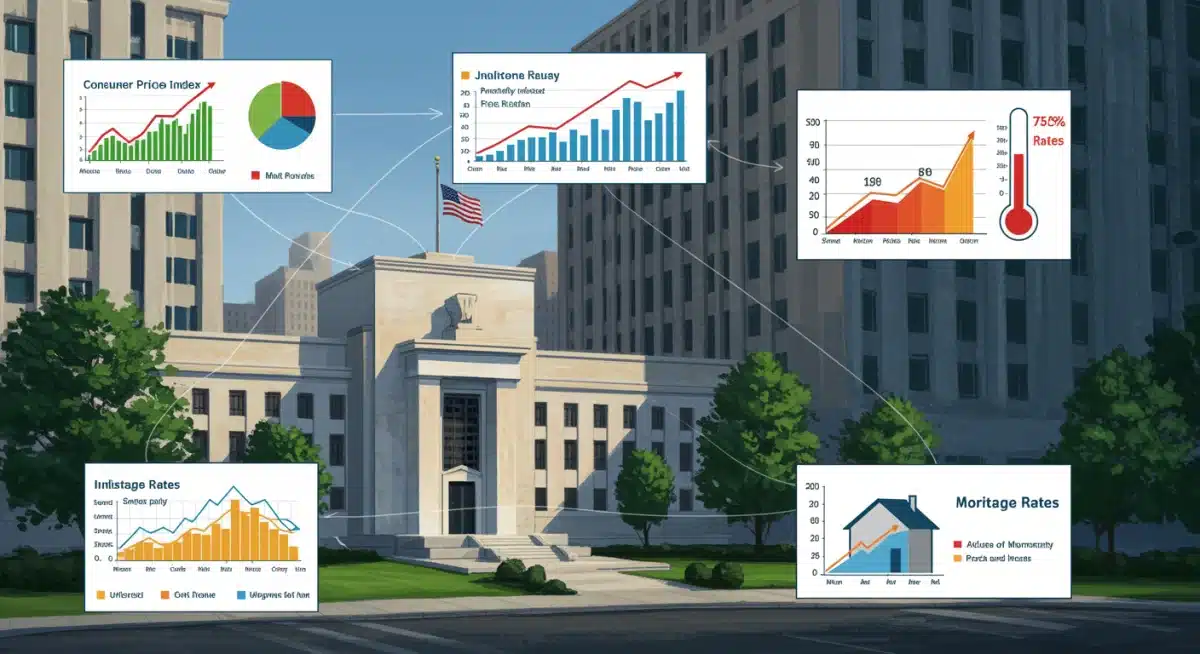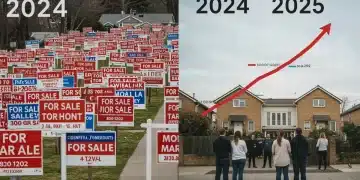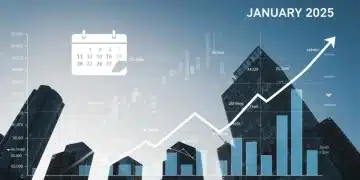Decoding Latest Mortgage Rate Projections for Next 6 Months

Understanding the latest mortgage rate projections for the next six months is crucial for navigating the financial impact on the housing market and personal finances.
Decoding the Latest Mortgage Rate Projections for the Next 6 Months (FINANCIAL IMPACT) is paramount for anyone considering a home purchase or refinancing in the current economic climate. Recent market shifts and Federal Reserve signals suggest a dynamic period ahead, directly influencing borrowing costs and housing affordability.
Understanding Current Mortgage Rate Trends
As of late May 2024, mortgage rates have shown a degree of volatility, influenced by a complex interplay of economic data and Federal Reserve policy. The recent Consumer Price Index (CPI) report, for instance, indicated a slight cooling in inflation, which can exert downward pressure on long-term interest rates, including mortgages. However, strong labor market data continues to fuel concerns about persistent inflation, leading to upward pressure.
Several key factors are currently shaping these trends. The Federal Reserve’s stance on interest rates remains a primary driver, with their recent meetings signaling a cautious approach to rate cuts. Geopolitical events also play a role, often leading to a ‘flight to safety’ in bond markets, which can indirectly affect mortgage rates. Understanding these underlying currents is essential for anticipating future movements.
The Federal Reserve’s Influence
The Federal Reserve’s monetary policy decisions, particularly regarding the federal funds rate, have a significant, albeit indirect, impact on mortgage rates. While the federal funds rate is a short-term lending rate, it influences the broader financial market, including the yield on 10-year Treasury bonds, which mortgage rates often track. Recent statements from Fed officials suggest a data-dependent approach.
- Cautious Stance: The Fed is currently maintaining a cautious stance, awaiting more definitive evidence of sustained disinflation before considering rate adjustments.
- Inflation Targets: Progress towards the Fed’s 2% inflation target is a critical determinant for future rate decisions.
- Economic Data: Employment reports, GDP figures, and manufacturing data are all closely watched by the Fed and, by extension, the mortgage market.
Key Economic Indicators to Watch
Several economic indicators are crucial for predicting the trajectory of mortgage rates over the coming six months. Inflation data, particularly the Consumer Price Index (CPI) and Personal Consumption Expenditures (PCE) price index, remains paramount. A sustained decline in these figures could pave the way for lower mortgage rates. Conversely, a resurgence in inflationary pressures would likely lead to higher rates.
Employment figures, including the monthly jobs report and unemployment rate, also provide vital insights. A robust job market, while generally positive for the economy, can signal inflationary pressures if wage growth outpaces productivity. Global economic stability and geopolitical tensions can also introduce volatility, causing investors to seek safe-haven assets, which can sometimes benefit mortgage rates by lowering bond yields.

Inflation and Its Impact
Inflation is arguably the most critical factor influencing mortgage rates. When inflation is high, lenders demand higher interest rates to compensate for the erosion of their future returns. The recent trend has shown some moderation, but it remains above the Federal Reserve’s target.
- CPI and PCE: These two indices are the primary gauges of inflation that the Fed monitors closely.
- Core vs. Headline: Core inflation (excluding volatile food and energy prices) often provides a clearer picture of underlying price trends.
- Future Expectations: Inflation expectations among consumers and businesses also play a role in how lenders set rates.
Forecasts from Leading Financial Institutions
Leading financial institutions and economists are offering varied, though generally convergent, mortgage rate projections for the next six months. Fannie Mae, for example, anticipates a gradual decline in 30-year fixed mortgage rates towards the latter half of the year, contingent on continued disinflation and a stable job market. Their latest forecast indicates rates potentially dipping below 6.5% by early 2025.
Similarly, the Mortgage Bankers Association (MBA) projects a modest decrease, suggesting that rates could fluctuate but trend downwards as the Federal Reserve potentially begins to ease its monetary policy. Bank of America and Wells Fargo also echo these sentiments, emphasizing that any significant rate cuts will be contingent on sustained positive economic data, particularly within the inflation landscape. These institutions stress that while the general direction might be downwards, volatility is to be expected.
Expert Consensus and Divergences
While a general consensus points towards a potential easing, there are nuanced differences in the magnitude and timing of predicted rate shifts. Some analysts believe that the Fed might act sooner than others, while a more hawkish view suggests rates could remain elevated for longer if inflation proves stickier. These divergences often stem from differing interpretations of current economic data and future market responses.
- Gradual Decline: Most experts foresee a gradual, rather than sharp, decline in rates.
- Data Dependency: All forecasts heavily emphasize the data-dependent nature of future rate movements.
- Market Volatility: Expect continued fluctuations in rates, even within a general downward trend.
Potential Scenarios for Mortgage Rates
Looking ahead, several potential scenarios could unfold for mortgage rates over the next six months, each with distinct implications. The most optimistic scenario involves a continued and consistent decline in inflation, allowing the Federal Reserve to implement multiple rate cuts. This would likely lead to a noticeable decrease in 30-year fixed mortgage rates, potentially pushing them into the mid-6% range or even lower, making homeownership more accessible.
A more moderate scenario suggests that inflation cools slowly, leading to fewer and more delayed rate cuts from the Fed. In this case, mortgage rates might hover in their current range, perhaps with slight downward adjustments, maintaining a relatively stable but still elevated borrowing cost environment. The most pessimistic outlook involves a resurgence of inflation or unexpected economic shocks, forcing the Fed to maintain or even increase rates, leading to higher mortgage costs and a further tightening of the housing market.
Impact of Economic Surprises
Economic surprises, both positive and negative, can swiftly alter mortgage rate trajectories. A sudden geopolitical event, a stronger-than-expected jobs report, or an unexpected dip in consumer spending can all trigger immediate reactions in bond markets, which then translate to mortgage rate shifts. These surprises underscore the inherent unpredictability of financial markets.
- Inflationary Shocks: Unexpected increases in energy or food prices could halt any downward trend in rates.
- Recession Fears: A significant economic downturn could prompt the Fed to cut rates aggressively, leading to lower mortgage costs.
- Geopolitical Events: Global instability often drives investors towards safer assets, impacting bond yields and mortgage rates.
Financial Impact on Homebuyers and Homeowners
The evolving landscape of mortgage rate projections carries significant financial implications for both prospective homebuyers and existing homeowners. For homebuyers, lower rates translate directly into increased purchasing power and more affordable monthly payments. A reduction of even half a percentage point can save thousands of dollars over the life of a loan, making the dream of homeownership more attainable or allowing buyers to afford a larger or better-located property.
Existing homeowners stand to benefit from lower rates primarily through refinancing opportunities. Those who secured higher rates during previous periods of market volatility could potentially lower their monthly payments, reduce the total interest paid over time, or access equity through cash-out refinancing. Conversely, if rates remain elevated or increase, affordability challenges will persist, potentially cooling demand in the housing market and impacting property values.
Strategies for Navigating Rate Changes
Given the dynamic nature of mortgage rates, adopting strategic approaches is crucial. For homebuyers, getting pre-approved for a mortgage provides clarity on affordability and locks in a rate for a limited period, offering some protection against sudden increases. Exploring different loan products, such as adjustable-rate mortgages (ARMs) for those comfortable with some risk, can also be beneficial.
- Rate Locks: Secure a rate lock to protect against upward rate movements during the home-buying process.
- Refinancing Evaluation: Homeowners should regularly evaluate their current mortgage against prevailing rates for potential refinancing savings.
- Financial Planning: Budget for potential rate fluctuations by maintaining a financial cushion.
Strategies for Navigating the Mortgage Market
Navigating the current mortgage market effectively requires a proactive and informed approach, particularly in light of the dynamic mortgage rate projections. For prospective homebuyers, understanding your financial readiness is the first step. This includes assessing your credit score, saving for a substantial down payment, and getting pre-approved for a mortgage. Pre-approval not only clarifies your budget but also signals to sellers that you are a serious and qualified buyer, which can be a significant advantage in competitive markets.
Homeowners looking to refinance should continuously monitor current rates and compare them against their existing mortgage. Even a small drop in rates could yield significant savings over the loan term. It’s also wise to consider the closing costs associated with refinancing, ensuring that the savings outweigh these upfront expenses. Consulting with a trusted mortgage professional can provide personalized advice tailored to your specific financial situation and goals, helping you to make the most informed decisions.
Tips for Homebuyers
For those entering the housing market, a strategic approach can mitigate the impact of fluctuating rates. Staying informed about economic news and Federal Reserve announcements is crucial, as these often precede rate changes. Flexibility in your home search, including considering different neighborhoods or property types, can also open up more affordable options.
- Credit Score Optimization: A higher credit score can secure better interest rates.
- Down Payment Savings: A larger down payment reduces the loan amount and can improve loan terms.
- Research Loan Options: Explore fixed-rate, adjustable-rate, FHA, and VA loan options to find the best fit.
For existing homeowners, evaluating refinancing opportunities becomes essential when rates shift. Even if current rates aren’t significantly lower than your existing rate, exploring options like shortening your loan term or switching from an adjustable-rate to a fixed-rate mortgage could be beneficial. Always consider the long-term financial implications and consult with a financial advisor to ensure any decision aligns with your overall financial strategy.
| Key Point | Brief Description |
|---|---|
| Federal Reserve Influence | Fed decisions on the federal funds rate indirectly impact mortgage rates, with current policy remaining data-dependent. |
| Inflation Data | CPI and PCE reports are critical; sustained disinflation could lead to lower mortgage rates. |
| Expert Forecasts | Most financial institutions project a gradual decline in rates, contingent on economic stability. |
| Financial Impact | Lower rates increase affordability for buyers and create refinancing opportunities for homeowners. |
Frequently Asked Questions About Mortgage Rates
Mortgage rate projections are primarily influenced by inflation data (CPI, PCE), Federal Reserve monetary policy, employment reports, and broader economic stability. Global events and investor sentiment also play significant roles in shaping these forecasts and actual market movements.
The Federal Reserve’s federal funds rate decisions indirectly impact mortgage rates by influencing the yield on 10-year Treasury bonds, which mortgages often track. A hawkish stance can push rates up, while easing policies typically lead to lower rates.
Homebuyers should consider getting pre-approved, securing a rate lock, and exploring various loan options like fixed-rate or adjustable-rate mortgages. It’s crucial to assess personal financial readiness and budget for potential rate fluctuations.
Yes, existing homeowners can benefit from potential rate declines through refinancing opportunities. Lower rates could reduce monthly payments, decrease total interest paid, or allow for cash-out refinancing to access home equity, depending on individual circumstances.
Reliable mortgage rate forecasts are typically provided by leading financial institutions like Fannie Mae, the Mortgage Bankers Association (MBA), and major banks. Consulting with a qualified mortgage professional can also offer tailored insights based on current market data.
Impact and Implications
The ongoing shifts in mortgage rate projections carry profound implications for the broader economy and individual financial planning. As the Federal Reserve continues to navigate inflation and employment data, the direction of mortgage rates will dictate the pace of housing market activity, influencing everything from new construction to consumer spending. Stakeholders across the board, from potential first-time buyers to seasoned real estate investors, must remain vigilant, adapting their strategies to the evolving economic landscape. The coming months will be critical in determining the long-term trajectory of housing affordability and investment opportunities.





